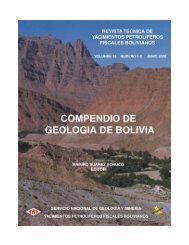Exploraciones por oro epitermal
You also want an ePaper? Increase the reach of your titles
YUMPU automatically turns print PDFs into web optimized ePapers that Google loves.
Corbett: Epithermal Gold For Explorationists<br />
Steam heated alteration occurs in the upper <strong>por</strong>tions of high sulphidation epithermal systems,<br />
typically as laterally extensive sheets within the vadose zone above the palaeo water table, but also<br />
locally collapsing down structures. Oxidation of magmatic sulphur-bearing volatiles in this<br />
environment produces locally (moderately) acidic warm waters which react with host rocks. While<br />
massive low temperature silica is locally present, typically at the base close to the water table, most<br />
of this zone comprises friable rock characterised by opal, powdery alunite, kaolin and sulphur. This<br />
soft alteration mineralogy is only preserved in youthful poorly eroded systems such as in the arid<br />
<strong>por</strong>tions of the high Andes (e.g., Pascua-Lama, Veladero, La Coipa). As a volatile-dominant low<br />
temperature alteration, cinnabar may be well developed, but gold-silver mineralisation is not<br />
expected, unless this alteration is telescoped (collapsed) upon earlier mineralisation. Acidic<br />
oxidizing waters collapsing down structures from the vadose zone may promote locally high grade<br />
mineralisation by mixing with rising pregnant magmatic fluids (e.g., Pierina, Veladero). Sulphur has<br />
been rarely mined from this alteration.<br />
The challenge for explorationists has been to prospect for mineralised feeder structures at depth<br />
below laterally extensive sheets of texturally destructive barren steam heated alteration. Geological<br />
mapping should seek to identify breccia systems which form im<strong>por</strong>tant fluid conduits in mineralised<br />
high sulphidation systems. It may be possible to project into an alteration zone from outside,<br />
structures which act as conduits for either rising mineralised fluids, or collapsing acid fluids as an aid<br />
to mineral deposition by fluid mixing.<br />
Magmatic solfataras are recognised as the direct venting of high temperature magmatic volatiles to the<br />
surface within active magmatic arcs. These are characterised by silica-alunite-kaolin alteration near<br />
vents and deposition of locally significant quantities of sulphur production (e.g., Kawah Ijen, former<br />
production from Biliran and White Is.). Although recent studies (Hedenquist et al. 1993) suggest that<br />
some magmatic solfataras deposit metals they do not constitute major ore systems.<br />
The term acid sulphate is now preferred for acid alteration formed by the reaction with host rocks of<br />
collapsing cool acidic condensate waters (Corbett and Leach, 1998), most notably in low sulphidation<br />
gold deposits including current geothermal systems (e.g., Waitapu, Photo 29; Lihir, Photo 30).<br />
Photo 29. Acid sulphate alteration typical of the<br />
surficial levels of low sulphidation systems,<br />
comprising cristobalite, silica, alunite. Note<br />
sulphur being deposited from steam vent.<br />
Waitapu.<br />
Photo 30. Acid hot spring and adjacent<br />
alteration, Lihir Is.<br />
Mainly argillic alteration comprises low temperature silica (opal, cristobalite), pyrite, and kaolin with<br />
minor sulphur, and is termed advanced argillic alteration where alunite is also present.<br />
Mineralised high sulphidation systems<br />
Mineralised high sulphidation epithermal gold deposits predominantly occur in younger poorly eroded<br />
magmatic arcs (e.g., Andes of South America), although some are noted on the older arcs of eastern<br />
Australia (e.g., Gidginbung, Peak Hill). Thus, most occur in volcanic host rocks and demonstrate<br />
Paper 2002-01, April 2002 19
















